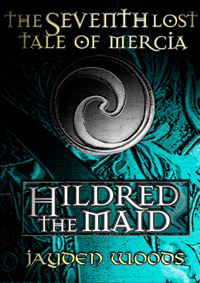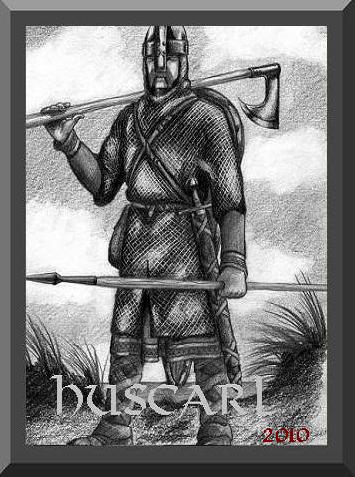In 11th century England, “hearth companion” was a general term for a lord’s household troops or personal bodyguards. However, hearth companions often did more than simply bear arms, and they were also known by other names: house-carls, huscarls, or gesitha. The terms changed and took on different meanings throughout the Anglo-Saxon and Viking period–there was even a time in which hearth companion and thegn meant the same thing. To avoid confusion in my own stories, I use the word “thegn” based on its legal definition, which was a man who owned five hides of land or more and provided at least one warrior (usually himself) for the king’s fyrd in times of war. I use “hearth companion” as the term for an Anglo-Saxon’s household troops, and “house-carl” for that of a Dane’s.
The status of the men who became hearth companions also varied considerably throughout the Viking Age. In the case of the king, his hearth troops might be composed of actual thegns and war-leaders, along with hand-picked warriors. In the case of a thegn distinguished enough to obtain his own hearth companions, they could be men to which he gave land, or men who simply ate off the lord’s table in exchange for their ongoing services. The lord might also provide them battle arms, horses, clothes, and a portion of his spoils in war, all of which would be returned to the lord upon the companion’s death or treachery (Thrupp 184).
“It was the proudest distinction of a Teutonic chief to be surrounded by a band of young companions whom he had attracted to his home by his reputation for hospitality, valour, and open-handedness. They came to him as reverential pupils and retainers, who hoped through him to learn the art of war, and to attain the fame that hallowed all the companions of a hero and a conqueror. They bound themselves to him as friends, pupils, and servants, anxious to participate in his triumphs and ready to share all his dangers.”
–Thrupp, 184
The primary purpose of the hearth companions was of a military nature. In battle, they directly surrounded and fought with their lord. But when they were not at war, the duty of the hearth companion became more malleable. “In times of peace, the king’s hearth companions were the nearest equivalent to a police force: they administered his laws and enforced his royal authority” (Lacey, 154-155).
As for the hearth companions of minor lords, their tasks might become very menial, everyday household duties. John Thrupp lists several aspects of the lord’s household that the hearth companions would divide and take charge of: the lord’s horses, stable, bedroom, clothes, dishes, money, and so forth (Thrupp 185). Therefore they might be given such titles as marshall, stall-man, bower-thegn, clothes-servant, hoarder, and so on. The lord might even make one of him his private executioner (such as Godwin Port-Hund in “Eadric the Grasper”). However, “Menial as were the tasks which the chief’s ‘companions’ performed, they, received, in return, attentions nearly as humble. It was the duty of the queen and princesses personally to make and mend their clothes” (Thrupp, 185).
By aligning themselves with a powerful lord, hearth companions rose and fell with their leader, gaining when he gained and losing when he lost. If a hearth companion betrayed his lord, he would lose everything his master had given him. The companions’ loyalty to the lord went unmatched, and with certainty one can surmise that they were also his advisers and closest friends.
WORKS CITED/CONSULTED
Lacey, Robert and Danny Danzinger. The Year 1000 : What Life Was Like at the Turn of the First Millennium. Little, Brown and Company, 1999. Print.
Levick, Ben. “Anglo-Saxon Military Organisation.” Regia Anglorum Publications 2002. Web. http://www.regia.org/saxons2.htm
Thrupp, John. The Anglo-Saxon Home: A History of the Domestic Institutions and Customs of England (from the Fifth to Eleventh Century). London, 1889.
NEXT TUESDAY:

In the year 1005 A.D., a terrible famine strikes Engla-lond. A poor young woman named Hildred is nearly destitute, and she does not know whether the thegn named Eadric will be her salvation or demise.





















Good post, Jayden! These elite warriors are fascinating, and usually forgotten in the history books, which still sadly insist that history began with William I…
By 1066, the huscarls in the service of King Harold, his brother-earls Gyrth and Leofwine and other earls such as Waltheof, Edwin and Morcar, probably numbered 2-3,000 in total, and were largely Anglo-Scandinavian in composition.
The Domesday book of 1086 shows that King Edward ‘the Confessor’ owned 15 acres at Wallingford (manebant)- a housecarl garrison.
Many ‘retired’ old warriors- some named in the DD Book- may even still have been alive by 1086 in some cases if not exiled or fled abroad, most must have been since slain in the three battles of 1066 or the anti-Norman revolts afterwards, during daily service or during revolts etc.
• Housecarls are not found owning or receiving in Surrey, nor near royal centres such as Gloucester or Winchester
• 41 men (28 of which had Danish names) are named as ‘huscarls’ in the DD book, some were even from Northern Europe.
Loyalty to their lord was the core of their honour code/law codes, pride and honour bound them to faithful sevice to their paymaster- and each other- even to their deaths.
The more wealth- and prowess in battle- an Earl/King had, the larger his following.
Defaulters within this elite brotherhood could be executed or banished with property confiscated- harsh compared to civil laws of that time.
Any internal disputes would be dealt with by their own assembly- the huscarlesteffne- which met with the king regularly who acted as ‘referee’.
The worst sentence was to be declared ‘niðing’ (a Norse word meaning coward or craven) and cast out of the Huscarls.
Thanks so much! I love that you mentioned the “retired” house-carls of 1086. I suppose as the Normans brought along the era of knights and so forth, hearth companions quickly became a lost concept. This will be great thing for me to explore in my book about “Edric the Wild”!
Yes, the Norman pride in their own war machine (fronted by the elite and hard-trained “cavalry”) was brought across to England, but they soon adopted the focus of infantry, which by the early medieval period was vital again (ie. men-at-arms dismounted at Agincourt).
In 1106 Henry won a battle at Tinchebrai over his brother Robert, using many English infantry as his main army, possibly the sons and grandsons of some of the warriors of 1066, as this battle was then widely seen as ‘revenge for 1066’!